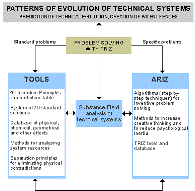|
The advantages and the success
potential by using TRIZ and Anticipatory Failure
Identification (AFI) have technical and psychological aspects.
Technical Aspects
• Completely new approaches for
solving problems in the most important company divisions: Research and
Development, Quality Control, Marketing, optimising of products and
processes etc.
• Faster and more effective problem solving and innovation processing by
rigorously avoiding trial-and-error methods. Reduced risks and costs during
the development stage.
• Forecasting the development of technical systems, creating protecting
patent fences, revealing uncovered product niches.
• Enhanced quality control and optimised products through a focussed search
for alternative solutions and the application of anticipatory failure
identification.
• Generating of ideas in seemingly hopeless situations, where practically
all conceivable solutions are covered by competitor’s patents.
• Optimal use of system resources: e.g. eliminating negative effects in a
machine or process by only slightly modifying the technical system.
• Integration and supplementation possibilities with DFSS (Design for Six
Sigma), DFMA (Design for
Manufacture and Assembly), FMEA (Failure Mode and Effects Analysis), QFD (Quality
Function Deployment), Value Engineering, Taguchi (Robust Design) and other
methods.
|
Psychological Aspects
• TRIZ increases the creativity and inventiveness of engineers and project
teams.
• TRIZ eliminates ‘habitual blindness’.
• TRIZ encourages systematic thinking processes and the will to search
for less trivial solutions.
• TRIZ improves teamwork; the invention process becomes a controllable
procedure and is no longer an act of pure inspiration.
|

